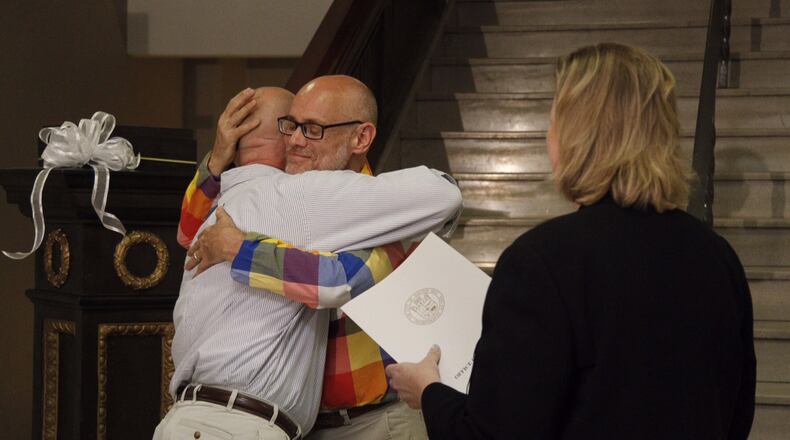With the ruling, the court invalidated a ban against same-sex marriage approved by Ohio voters in 2004. By doing so, the justices overturned a decision by a federal appeals court in Cincinnati which upheld same-sex marriage bans in Ohio, Kentucky, Tennessee and Michigan.
Justices Sonia Sotomayor, Ruth Bader Ginsburg, Stephen Breyer, and Elena Kagan joined Kennedy to form the majority while Chief Justice John Roberts and Justices Antonin Scalia, Samuel Alito, and Clarence Thomas dissented.
When the decision was announced, the hundreds of people outside the court began singing the national anthem and chanted “U-S-A, and “love has won.”
Among those waiting outside the court for the ruling was James Obergefell of Cincinnati, who in 2013, along with his spouse, John Arthur, challenged Ohio’s ban on same-sex marriage just months before Arthur died of Lou Gehrig’s disease.
As he spoke to reporters, Obergefell received a telephone call from President Barack Obama on his cellphone. After a few seconds, a choked up Obergefell said, “Thank you, Mr. President.” Obergefell and the president spoke for a few minutes more.
Moments later, Obama told reporters gathered in the Rose Garden “this morning the Supreme Court recognized marriage equality. In doing so, they have reaffirmed that all Americans are entitled to the equal protection of the law.”
Kennedy ruled that “same-sex cou¬ples may exercise the fundamental right to marry in all states. It follows that the court also must hold — and it now does hold — that there is no lawful basis for a state to refuse to recognize a lawful same-sex marriage performed in another state on the ground of its same-sex character.”
Kennedy wrote that “no union is more profound than marriage, for it embod¬ies the highest ideals of love, fidelity, devotion, sacrifice, and family. In forming a marital union, two people be¬come something greater than once they were.”
He wrote that gay couples have the hope of not being “con¬demned to live in loneliness, excluded from one of civiliza¬tion’s oldest institutions. They ask for equal dignity in the eyes of the law. The Constitution grants them that right.”
The ruling was not unexpected. Just two years ago in United States v. Windsor, Kennedy provided the fifth and decisive vote as the court invalidated a 1996 federal law defining marriage as between a man and a woman.
The justices issued their ruling as public opinion has dramatically changed. In November 2004, 61.7 percent of Ohio voters approved a constitutional amendment prohibiting same-sex marriage.
In a dissent, Roberts pointed out that the Supreme Court is “not a legislature. Whether same-sex marriage is a good idea should be of no concern to us. Under the Constitution, judges have power to say what the law is, not what it should be.”
Relying on the same legal reasoning he used to uphold Thursday the 2010 health care law, Roberts wrote that 37 states and the District of Columbia had already legalized same-sex marriage – either through a vote by their legislatures or through the courts.
He wrote “many people will rejoice at this decision, and I begrudge none their celebration. But for those who believe in a government of laws, not of men, the majority’s ap¬proach is deeply disheartening.”
“Supporters of same-sex marriage have achieved considerable success persuading their fellow citizens — through the democratic process — to adopt their view,” Roberts wrote.
“That ends today,” Roberts wrote. “Five lawyers have closed the debate and enacted their own vision of marriage as a matter of constitutional law. Stealing this issue from the people will for many cast a cloud over same-sex mar¬riage, making a dramatic social change that much more difficult to accept.”
House Speaker John Boehner, R-West Chester, expressed disappointment in the ruling, saying that the justices “disregarded the democratically-enacted will of millions of Americans by forcing states to redefine the institution of marriage.”
“My views are based on my upbringing and my faith,” Boehner said. “I believe that marriage is a sacred vow between one man and one woman, and I believe Americans should be able to live and work according to their beliefs.”
About the Author
